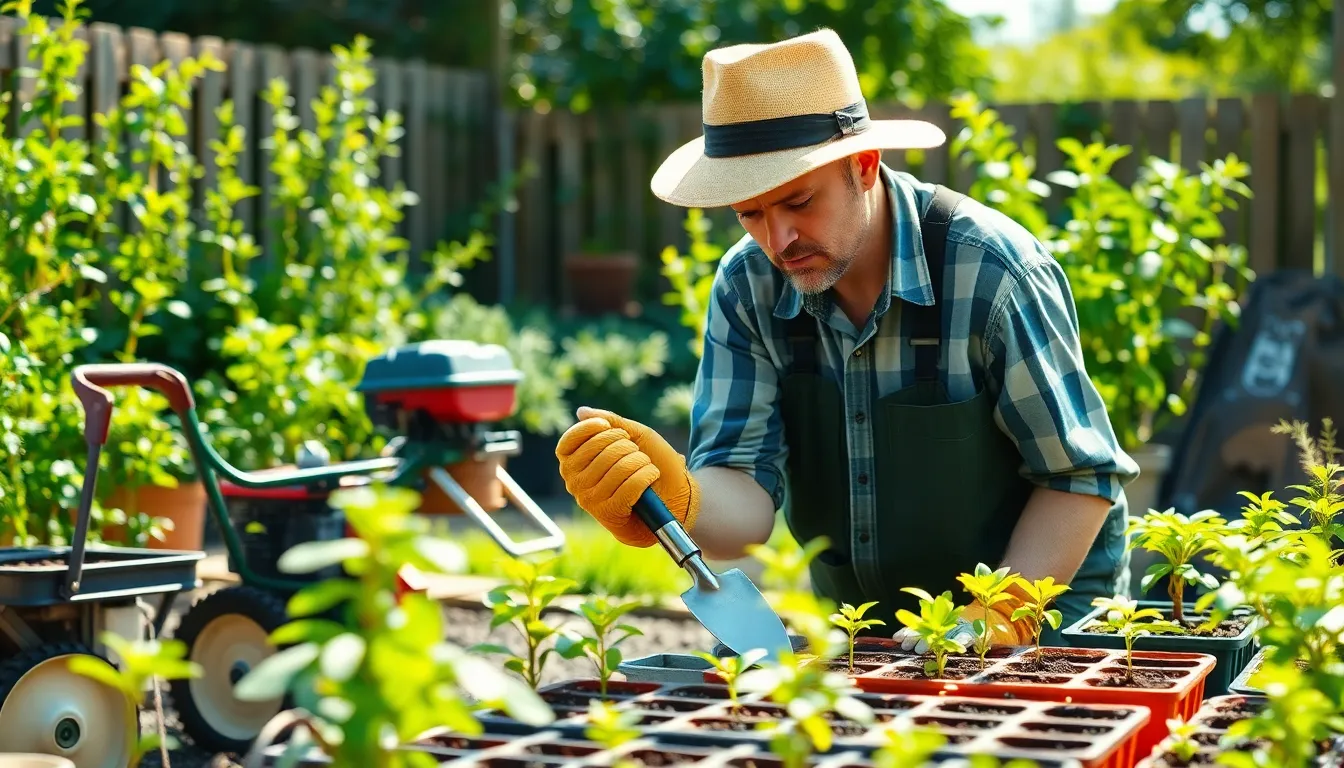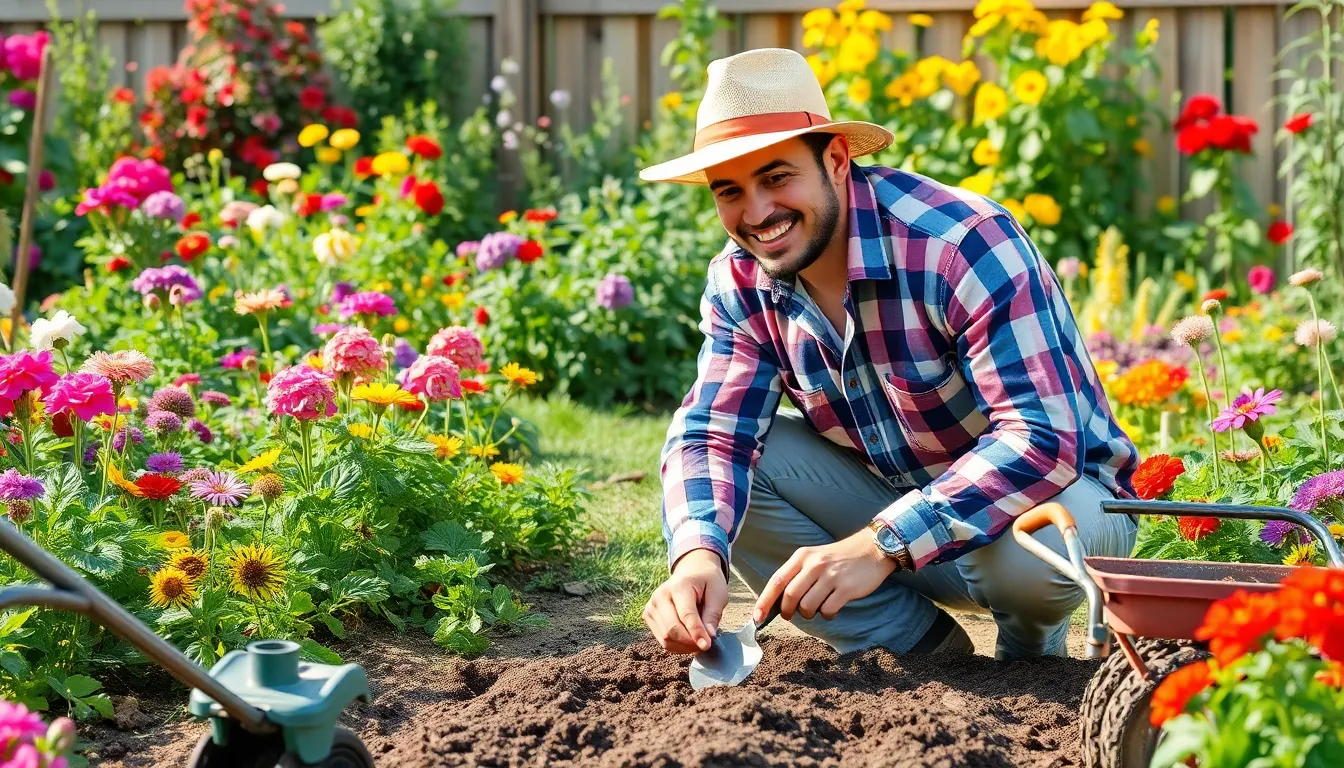Planting Equipment: Unlock Your Garden’s Potential with the Right Tools

When it comes to planting, having the right equipment can make all the difference between a thriving garden and a patch of sad, wilted plants. Imagine trying to dig a hole with a spoon—frustrating, right? That’s why investing in quality planting equipment is essential for anyone serious about gardening. From seeders that make planting a breeze to tillers that turn soil into a fluffy paradise, the right tools can transform an arduous task into a delightful experience.
Planting Equipment
Using the right planting equipment makes gardening more efficient and enjoyable. Various tools cater to different planting needs, from hand tools to advanced power tools.
Hand Tools
Hand tools are essential for precision tasks in the garden. Items like trowels help with digging and planting seeds, while transplanters ensure plants are moved with care. Pruners assist with trimming excess foliage, allowing better light exposure for new growth. Rakes help level soil and remove debris, promoting a cleaner planting area. These tools typically require little maintenance and offer versatility for various gardening tasks.
Power Tools
Power tools offer convenience and speed, especially for larger planting projects. Tillers break up compacted soil, enhancing aeration and nutrient absorption. Seeders automate the process of sowing seeds, ensuring even distribution and optimal depth. Watering systems, such as drip irrigation, deliver moisture directly to root zones. Garden mulchers make quick work of yard waste, providing mulch that retains soil moisture and suppresses weeds. Investing in reliable power tools can significantly boost productivity in the garden.
Choosing the Right Planting Equipment

Selecting the appropriate planting equipment plays a crucial role in gardening success. Consider several factors when making a decision.
Factors to Consider
Evaluate the size of the garden before choosing equipment. Larger gardens benefit from power tools like tillers, which save time and energy. Smaller spaces often require hand tools, such as trowels and pruners, for precision work. The type of plants also influences equipment choice; certain seeders work best with specific seeds. Additionally, consider the soil type, as some tools perform better in different soil conditions. Evaluate the frequency of use as well; investing in durable tools makes sense for regular gardeners while occasional users may prefer basic options.
Budget Considerations
Establishing a budget is vital for selecting planting equipment. Assessing needs helps prioritize purchases. Quality tools often come with higher initial costs but deliver better performance and longevity. Implementing a phased buying approach allows gardeners to spread expenses over time. Look for brands with warranties or guarantees, offering assurance on investments. Consider second-hand tools as more affordable options; they can provide excellent value if maintained well. Ultimately, balancing cost against functionality and durability ensures effective spending.
Maintenance of Planting Equipment
Proper maintenance of planting equipment ensures optimal performance and longevity. Regular checks can prevent costly repairs and enhance the gardening experience.
Regular Maintenance Tips
Inspect tools for damage before every use. Clean soil and debris from hand tools to prevent corrosion. Lubricate moving parts on power tools regularly for smooth operation. Sharpen blades consistently to promote clean cuts. Store equipment in a dry place to avoid rust and deterioration. Check the fuel and oil levels for power tools before operation. Follow the manufacturer’s instructions for specific care requirements.
Troubleshooting Common Issues
Tools may fail to start for several reasons. Fuel quality might be poor, so ensure fresh fuel is used. If a tiller struggles to penetrate soil, check the blade sharpness and adjust accordingly. A seeder may not distribute seeds evenly; inspect the seed rate settings. Additionally, dirt buildup can cause blockages, leading to power losses. For electrical equipment, assess the power source and cords for any signs of wear. Consult the user manual for guidance on more complex issues.
Innovative Planting Equipment
Innovative planting equipment enhances efficiency and effectiveness in gardening. Automated seeders streamline the planting process, allowing for precise spacing and depth. These machines reduce labor time, making large-scale seed planting quicker and more accurate.
Smart tillers introduce advanced features for soil preparation. They often include adjustable tines and variable speeds. With these tools, gardeners can easily tailor their approach to different soil types and conditions. Precision is vital for optimal growth, and these tillers provide that flexibility.
Drones for planting combine technology with traditional methods. These aerial devices can survey gardens to assess conditions before planting, ensuring informed decision-making. Using drones, gardeners gain insights on soil health and moisture levels, which facilitates better planting strategies.
Additionally, biodegradable seed pods are gaining popularity. Each pod contains seeds and nutrients, simplifying the planting process. Gardeners plant them directly into the soil, leading to reduced waste and improved germination rates. This eco-friendly solution appeals to environmentally conscious gardeners.
Robotic planting assistants reflect the latest trends in automated gardening. These devices perform multiple tasks, from preparing the soil to planting and watering. By utilizing robotics, gardens transform into high-efficiency production spaces, minimizing manual labor.
Wireless soil sensors contribute invaluable data for planting decisions. These sensors track moisture, pH levels, and temperature, providing real-time feedback. Gardeners can adjust their planting techniques based on accurate, up-to-date information.
Investing in these innovative tools boosts productivity and plant health significantly. Cutting-edge equipment addresses various gardening needs, making it essential for anyone passionate about growing plants.
Conclusion
Choosing the right planting equipment is crucial for any gardener aiming to achieve success. Quality tools not only enhance efficiency but also contribute to healthier plants and a more enjoyable gardening experience. By understanding the specific needs of their gardens and considering factors like size and soil conditions, gardeners can make informed decisions about their equipment.
Investing in maintenance and staying updated with innovative tools can further elevate gardening practices. From automated seeders to smart tillers, these advancements provide valuable support in maximizing productivity. Ultimately, the right tools and proper care lead to thriving gardens and satisfied gardeners.



